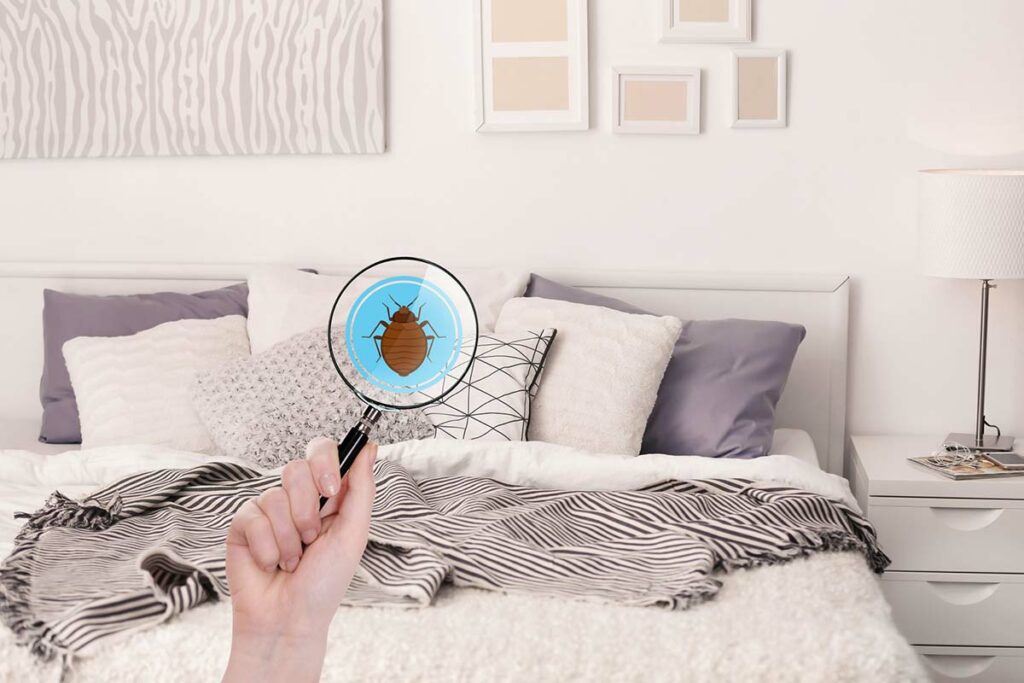
5 Key Warning Signs And Symptoms Of Bed Bugs
Have you ever wondered, “Does my house have bed bugs?”
It’s a scary question for anyone to ask themselves, but the truth is bed bug infestations are a lot more common than you may think. There used to be a stigma that bed bugs could only be found in dirty homes, but no home is safe.
The most common way people get bed bugs is through traveling. Bed bugs are sneaky pests, which means they can hide in your luggage, purse, or even your clothes. Once you bring those belongings home, the bed bugs will crawl out and make themselves comfortable in their new environment.
Since it’s easy for anyone to bring bed bugs home with them, learning the signs of an infestation can help you stay clean and safe. The sooner you can recognize that you have a problem, the easier and faster it will be to fix it.
Do you want to know how you can tell you have a bed bug infestation? Keep reading to learn the top 5 signs.
1. Bites: How to Tell If I Have Bed Bug Bites
The most common way people discover they have bed bugs is finding bites on their bodies. Since lots of bugs can bite, it’s helpful to learn how to identify bed bug bites so you can understand what’s inside your home.
Bed bugs prefer to bite exposed skin, so your arms, shoulders, neck, face, the bottom of your legs, and any other areas that aren’t covered by blanket are their easiest targets. Bites typically come in clusters and sometimes there can be a distinct zigzag pattern. The bite itself isn’t painful, but you can experience itchiness, redness, and swelling once your skin reacts to the bite.
2. Droppings: What They Look Like and Where to Find Them
Since bed bugs feed on blood, this means their droppings are dark and have a similar appearance to coffee grounds. If you poke it with your finger, you may even be able to smear old blood. Bed bugs don’t like to travel far from their food source, so you’ll most likely find their droppings on your sheets, pillowcases, bed frame, nightstand, and any other furniture that’s close to your bed.
3. Eggshells and Other Body Parts
The bed bug life cycle involves shedding many shells as they continue to grow. Bugs have exoskeletons, which means the shells they molt look the same as a live bed bug. Bed bugs and bed bug shells are reddish-brown, round, and around 4 mm long. Bed bugs have a shape, color, and size that’s similar to an apple seed, which can make identifying them and their shells easier.
4. Bed Bugs Themselves: How to Find Their Hiding Spots
Bed bugs are sneaky, so you probably won’t ever see one unless you notice these other telltales signs first then decide to go searching for them. If you think you may have these other symptoms, finding the bed bug lair is the quickest and most definitive way to confirm if you have an infestation.
To find bed bugs, you’ll need to have a flashlight on hand because you’ll be looking in dark, hidden places. Since bed bugs need to be close to their food source, the mattress should be the first place you look. If you lift up your mattress, you may be able to spot them close to the corners.
If your mattress is clean, you should move onto the headboard next. All you have to do is shine your light behind it and look for any movement. Other areas that are worth investigating include the underside of your furniture near your bed, inside outlets, within your curtains, and behind any paintings you may have.
5. You Travel a Lot Or You Know Someone Who’s Had an Infestation
Since bed bugs won’t invade your home unless you travel or know someone who’s had bed bugs, you can help prevent an infestation by being cautious. Now that you know where bed bugs like to hide, you should start getting into the habit of inspecting your hotel rooms whenever you travel. Whether you’re staying in an old motel or a luxurious 5-star resort, any room can have bed bugs.
If you do find bed bugs in the room, your luggage could now be a transportation vessel. This means you should never bring your luggage inside your home once you return. If you can’t discard some belongings, you’ll have to unpack outside, inspect carefully, and sanitize as best as you can. Washing your clothes in hot water with detergent then drying on your hottest setting should be enough to kill any hitchhikers.
What Should You Do If You Have a Bed Bug Infestation?
Bed bugs are notoriously tricky pests. Not only are they great at hiding, but they can survive even the harshest and most thorough at-home treatments. This is why it’s best to call a professional right away since pest control companies have tons of experience with eliminating bed bugs efficiently.
The biggest risk of trying at-home treatments is that you’ll be giving the bed bugs more time to reproduce, which makes treating the infestation harder. In addition, humans can develop an allergy to bed bugs over time. If you keep receiving more bites, your body can start experiencing more severe reactions, such as blisters, hives, or even difficulty breathing.
Does Your Home Show Signs of Bed Bugs?
Although it’s unnerving to think about bed bugs calling your house their home, it’s important to educate yourself on the symptoms of an infestation. As long as you stay calm and get professional help immediately, you’ll be able to keep your house clean and safe.
If you’ve discovered bed bugs or any other unwelcome pest in your home, Pegasus Pest Control would love to help you with any job. Contact us to learn more about our services, our available specials, and to schedule your free inspection today.
